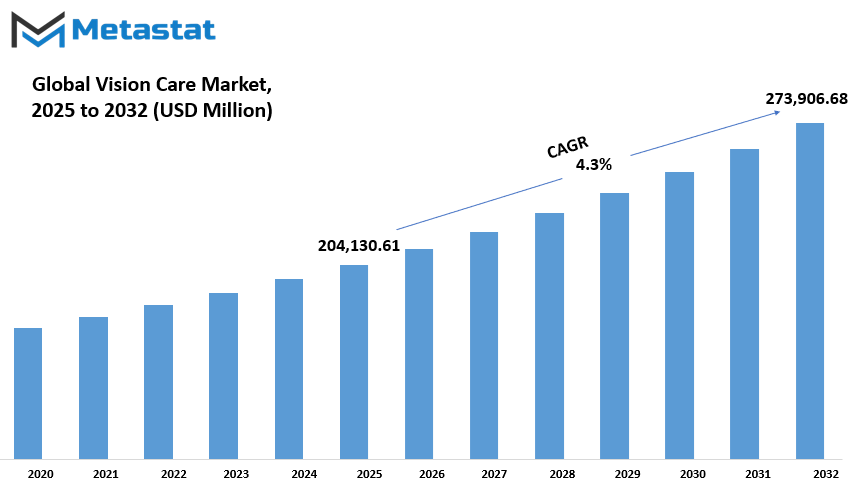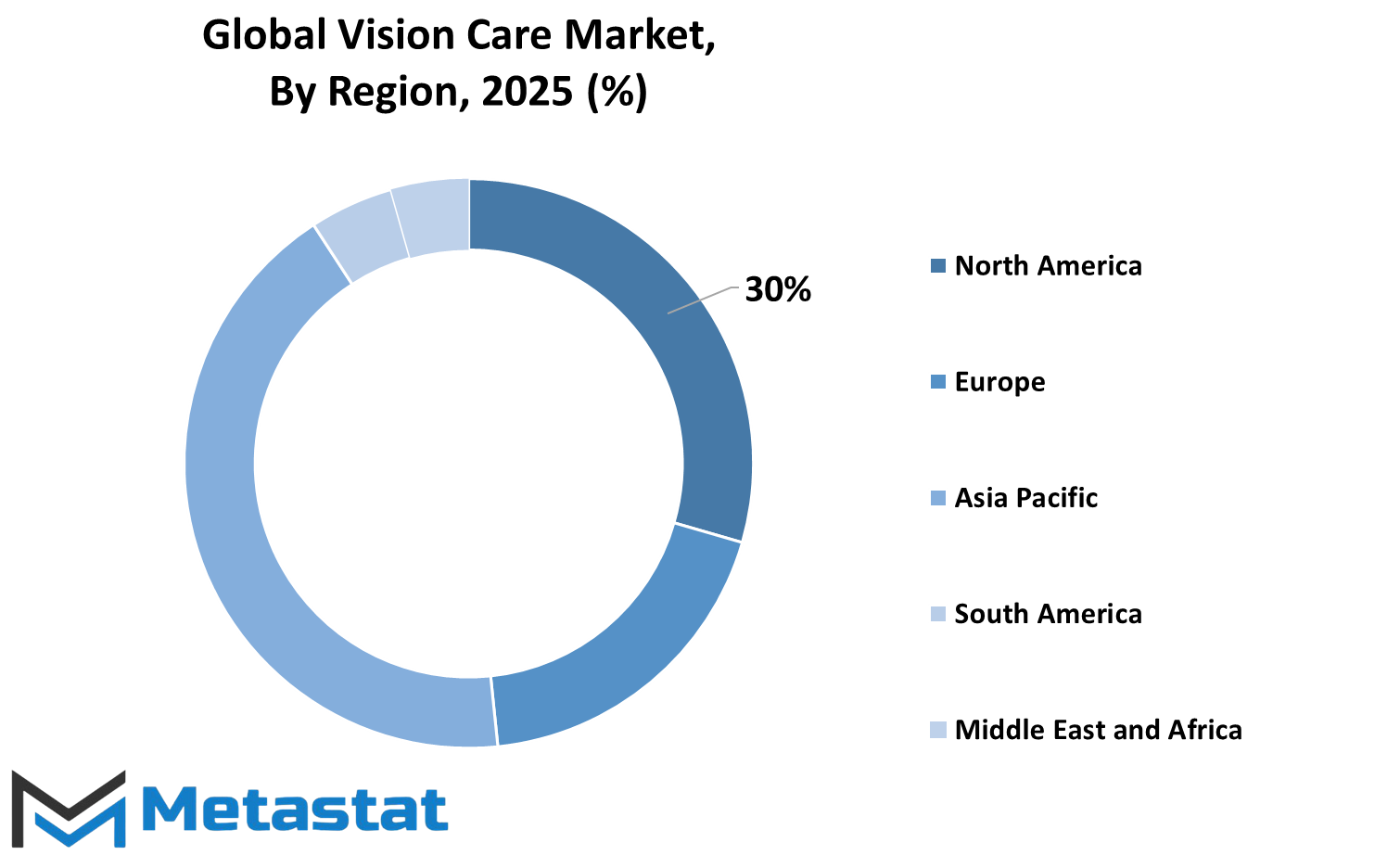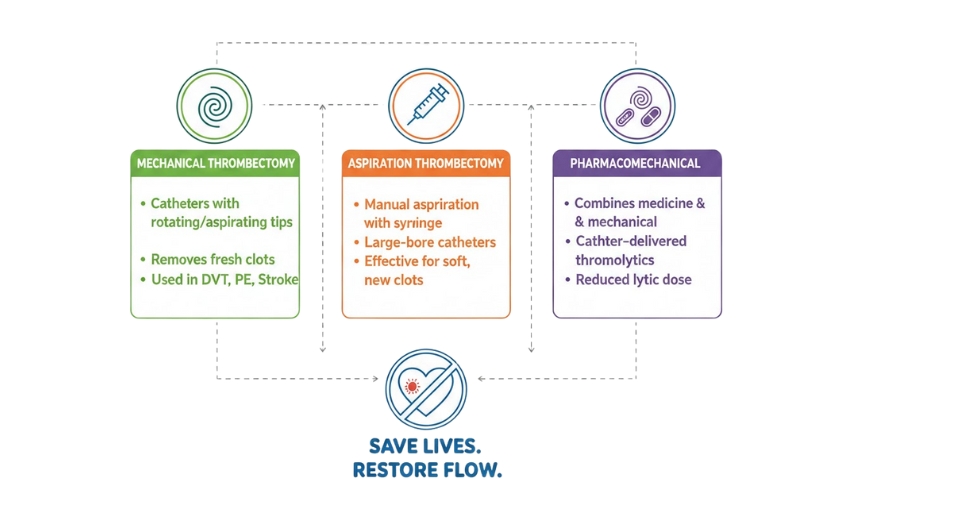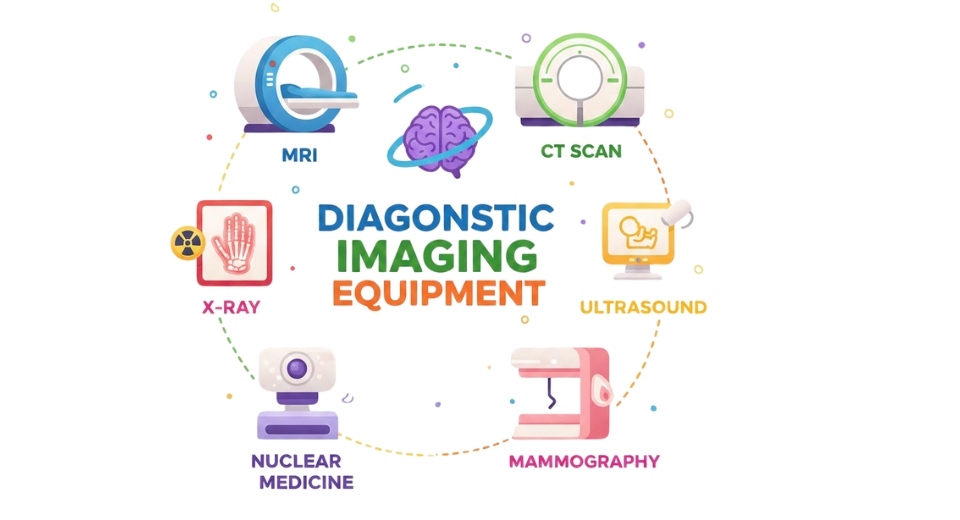MARKET OVERVIEW
The global vision care market is the lifeline of the healthcare industry, which includes a wide range of services and products dealing with the maintenance and improvement of eye health. It's a sector, with recent developments in technology and research continually shaping it, that will adapt in ways that redefine treating vision-related problems around the globe. It is a dynamic and specialized field that caters not only to existing visual impairments but also to preventive care, innovative treatment methodologies, and access to underserved populations.
Technological integration with collaboration among different disciplines will surely lead to drastic changes in the industry. The diagnosis of conditions such as glaucoma, cataracts, and macular degeneration will be done more accurately and sooner with better diagnostic tools, including AI-powered imaging systems. Such advancements will focus on an active approach toward eye health, where treatment at the right time reduces the possibility of severe visual impairment. Furthermore, innovations in wearable technology would be a contributor to this industry, providing real-time data monitoring and new opportunities for personalized care plans.
The global vision care market will likely experience an expansion in its scope as it embraces inclusivity and accessibility. Efforts to bridge the gap between developed and developing regions are expected to intensify, with organizations working to provide affordable vision care solutions in low-resource settings. Initiatives that prioritize mobile eye care units, telemedicine, and subsidized treatments are anticipated to shape the market's focus on equitable healthcare delivery.
Besides catering to human vision needs, this industry can expand its reach to veterinary care and meet the ocular health needs of animals. Domestic pets and livestock may receive specialized treatments and products, thus emphasizing the interdependence of healthcare among species. This diversification will not only open the market to more possibilities but also create a greater appreciation for ocular health as part of general well-being.
Environmental sustainability will also play a more significant role in the global vision care market. The production and disposal of optical products, such as lenses and frames, will be under more scrutiny. Eco-friendly alternatives and sustainable manufacturing processes will likely become standard industry practices, reflecting a commitment to environmental responsibility.
Another area that would potentially shape this market is advanced genetic research integration. Gene therapy to treat inherited eye diseases would gain importance, perhaps as the most viable and promising long-term remedy for untreatable conditions in the past. Quality care would not only be improved but also ushered into an altogether new front in medical science with this innovation.
In the future, the global vision care market will redefine the old boundaries by providing interdisciplinary collaborations in healthcare, technology, and environmental stewardship. As consumers grow in awareness, demand for holistic approaches to eye care is expected to surge, pushing the industry to come up with innovative, patient-centric solutions. This market's future will be well beyond conventional practices, promising a reimagined landscape where vision health takes center stage in global healthcare priorities.
The global vision care market would play an integral part in fashioning the healthcare of the present, future individual, community, and planet when aligned with its goals to move along with technology advancement and responsible use.
Global vision care market is estimated to reach $273,906.68 Million by 2032; growing at a CAGR of 4.3% from 2025 to 2032.

GROWTH FACTORS
The global vision care market is expanding quite rapidly, coupled with a significant shift in both lifestyle and demographic trends. High prevalence of eye problems, the main reason behind this trend, can be further associated with growing screen time usage and the graying of the global population. People spend considerable hours in front of digital appliances, which exposes them to risk factors such as eye strain or other vision concerns. This has resulted in a need for vision care solutions that address modern challenges effectively. In addition, as people are living longer, the demand for treatments related to age-associated vision problems, including cataracts and macular degeneration, continues to rise.
Growing awareness about eye health is another major reason behind the growth of the market. People have now become more conscious of seeking regular check-ups and early detection of problems in their eyes. Campaigns and educational initiatives have played an important role in encouraging people to care for their eyes, thereby increasing demand for professional eye care services and products.
However, the market is not problem-free. Expensive treatments provided by advanced vision care can deter many people from accessing them because of their very high costs; these are, however, exclusive to low-income groups. Additionally, in most rural and undeveloped places, access to such basic services as eye care is still difficult. These obstacles will hinder extensive adoption of these advanced vision care solutions, leading to a growth slowdown in such areas.
Despite these challenges, the advancements that are emerging into the market are promising. For instance, smart glasses and AI-sight correction treatments are changing the diagnosis and management of vision problems. Such technologies give possibilities of more precise and customized care, attracting not only the patients but the practitioners too. As such positive advancements become accessible to use, they are likely to impact the course of the global vision care market.
Therefore, the global vision care market is in a sense driven by the combined action of increasing awareness, new technologies, and rising vision problems associated with modern lifestyles and aging. Challenges like high prices and limited accessibility are areas that will oppose the growth, but prospects on the whole seem bright due to advancements that may bridge accessibility gaps and improve efficiency in delivering vision care.
MARKET SEGMENTATION
By Product Type
The global vision care market is a large and diversified industry, catering to millions of people looking for solutions for their eye health and visual needs. This market has experienced steady growth in recent years with advancements in technology and growing awareness about eye care. Product types in the vision care sector cater to different requirements, ensuring that people have access to effective solutions for maintaining or improving their eyesight.
Among the leading segments, spectacle lenses account for a significant market share, which amounts to $73,267.55 million. Lenses have remained the heart of vision correction since they address the most common refractive errors of the population, namely myopia, hyperopia, and astigmatism. Over the years, innovations have aided in the enhancement of functionality and comfort of spectacle lenses, thus becoming the primary corrective measure for millions of people across the globe.
Contact lenses have also taken a niche market for those who prefer not wearing glasses. Various types of lenses are available including daily disposables and extended wear lenses. Convenient and natural appearance are the complementing cleaning and disinfecting solutions that have to be employed in order to ensure hygiene and longevity of these contact lenses that would enable them to be safely and comfortably used.
Eye glasses is an overall category encompassing all corrective lenses. Therefore, the main categories under the eye glasses range include prescription glasses, fashion eyewear, and protective glasses. It is appealing since it can also be a matter of style to correct vision in many people. Intraocular lenses are the other advanced section, where one uses in most cataract operations to replace the natural lens. These lenses have transformed the treatment of cataracts, providing better outcomes for patients and fueling market growth.
Other products in the global vision care market offer niche solutions, meeting individual needs and preferences. Together, these segments show the scope of the market and the dedication of industry leaders to addressing diverse eye care needs.
With increased awareness towards eye health, and with better technological advancements over time, it is well-situated in the global vision care market for a further expansion ahead. Its large portfolio of different products ensures options for people in all age categories and needs toward optimal eye health and quality life.
By Type
The global vision care market is healthy and steadily on the growth chart due to rising demand for eyewear products as well as innovation in eye health technologies. The market can broadly be divided into two categories: Prescription (Rx) and Non-Prescription (Non-Rx). Prescription eyewear is put on by individuals who cannot see clearly and hence need corrective eyeglasses or lenses due to myopia, hyperopia, or astigmatism.
Most prescription eyeglasses already come pre-made to fit anyone that will put them on, so whatever product is produced will do their job well enough for the common vision problems. As aging becomes a rapidly increasing problem, with more elderly people developing significant eye problems and vision issues in general, increased demand for prescription eyeglasses is expected globally. Other concerns include better quality lens coatings, materials, as well as strength and durability regarding prescription eyewear.
Non-prescription eyewear, on the other hand, is all eyewear that does not require a prescription to use. It includes reading glasses, sunglasses, and even fashion eyewear more recently. Mainly used for either protective or aesthetic value. It has become extremely popular among individuals without vision impairment issues but need to protect the eyes from hazardous UV rays or digital screens' emitted blue light. Demand for non-prescription eyewear increased due to rising awareness in the protection of the eyes and a high rate of increase in screen time. The more people become conscious of proper eye care, the more the non-prescription eyewear business is thriving in developed and emerging markets.
Both segments have gained over the last couple of years through digital progression, wherein it's easier and more convenient for one to buy eyewear via online platforms. This has enabled consumers to explore a wide variety of products from the comfort of their homes, boosting both prescription and non-prescription eyewear sales. Online shopping convenience, combined with virtual try-on features and detailed product information, has made it easier for consumers to choose the right eyewear for their needs.
Prescription and non-prescription eyewear will continue to play a vital role in solving the needs of the global vision care market. With ongoing innovation and increasing consumer awareness, the market is bound to expand with an array of products that cater to different preferences and requirements.
By Distribution Channel
The global vision care market has played a very significant role in enhancing the quality of life by helping individuals realize a sound vision care. Vision care is essential to the overall well-being as healthy eyesight heavily impacts daily activities and productivity. The growth rate of this market is propelled by the growing awareness of eye health, the advancement of medical technology, and the rise of vision-related conditions such as myopia, cataracts, and glaucoma.
Distribution channels are one of the key aspects of the global vision care market. It signifies that the products and services reach the customers efficiently to cater to diversified needs and preferences. All the developed and some of the emerging markets have hospitals as important providers of advanced eye care, offering treatments and surgeries for complex issues. Ophthalmic clinics provide specialized eye care to patients, with the added provision of diagnostic services.
Optometrist shops are equally an important segment of the market in which people can get specific care, buy glasses or lenses contact, and get their prescriptions renewed. Electronic commerce is another factor that has impacted the market to a large extent by giving people an easy source to access eyewear and other products online. Retail hypermarkets and superstores also increase accessibility in vision care products for greater audience through convenience.
Technological development has furthered the global vision care market through innovative solutions in common vision problems. For example, contact lenses that are much more comfortable and durable have now become more widely accepted. Just like this, lens manufacturing developments have allowed eyeglasses to be made according to individual needs. Progressive lenses and anti-reflective coatings can be produced now.
Awareness campaigns and health initiatives by governments and organizations worldwide, due to an increasing prevalence of vision disorders, have also focused on the campaigns. These will educate the public on the need for regular check-ups and the early detection of conditions that can cause vision loss. More people will seek professional care, further expanding the market.
In conclusion, the global vision care market addresses a very important need: it solves the problems related to eye health and, at the same time, enhances quality of life. Its diversified channels of distribution and the adoption of innovative technologies guarantee that people have access to the products and services they need. The more awareness increases and progress develops, the more integral the vision care market will be in the maintenance of individuals' well-being across the globe.
By End-User
The global vision care market essentially portrays the growing needs of individuals who require solutions to maintain and improve their eye health. This market can be distributed into various end-user segments, such as eye hospitals and clinics, ambulatory surgery centers, optical stores, and others. Every segment caters to specific needs and contributes to the overall advancement of vision care services.
An eye hospital and clinic play a foundational role in the vision care market because it provides specialized medical care. Diagnostic and therapeutic services make them capable of offering treatment for most eye problems, be it refractive errors or complex disorders. Advancements in technology have allowed these institutions to do even better in caring for patients, so diagnoses are more promptly and accurately made.
Ambulatory surgery centers make a significant contribution in the global vision care market, too. Being outpatient-focused centers, they happen to be convenient places for patients needing surgical interventions in the form of cataract removal or laser-assisted treatments. Their efficiency and cost-effectiveness appeal to many patients, hence reducing the load on traditional systems of hospitals.
Another big category that can easily be accessed by any person looking for a vision correction solution is optical stores. They have a wide variety of products such as prescription glasses, contact lenses, and sunglasses. Most optical stores nowadays offer eye exams in-house, so customers can get all their vision needs met in one visit. This convenience and efficiency in optical care are enhanced through the integration of services.
The last category is "others," which includes all other facilities and services that are supplementary to the vision care market. This can include educational programs, research centers, and community initiatives aimed at raising awareness about eye health. All these efforts contribute to a greater understanding of the importance of vision care and encourage proactive measures for maintaining eye health.
Concluding the discussion, various segments within this global vision care market can serve diverse needs. Ranging from the specialist of an eye hospital and the operational competence of ambulatory centers to accessible optical stores, and a suite of other supplemental services, these all combine in meaningful ways to facilitate improved vision care. Providing each form of assistance will allow one the ability to be able to conserve his sight or even help maintain an elevated level of life.
|
Forecast Period |
2025-2032 |
|
Market Size in 2025 |
$204,130.61 million |
|
Market Size by 2032 |
$273,906.68 Million |
|
Growth Rate from 2024 to 2031 |
4.3% |
|
Base Year |
2024 |
|
Regions Covered |
North America, Europe, Asia-Pacific, South America, Middle East & Africa |
REGIONAL ANALYSIS
The global vision care market has tremendous growth potential, with its segmentation offering a comprehensive view of its different geographic regions. This segmentation makes it easier to understand the market's distribution and opportunities across different parts of the world. The North American region, being a significant region within this market, is further categorized into the United States, Canada, and Mexico. These countries are essential in the market because of their developed healthcare systems and the rising cases of eye disorders.
The Europe market is further divided into the United Kingdom, Germany, France, Italy, and the Rest of Europe. Medical infrastructure in all these countries are strong, along with a steadily increasing interest towards vision care technological advancements. Here, innovations that are developed consistently contribute to forming effective treatments as well as products for maintaining eyesight.
The Asia-Pacific region is filled with tremendous growth potential, and hence, it is segmented into countries like India, China, Japan, South Korea, and Rest of Asia-Pacific. This region enjoys a large population base, vision health awareness, and better access to medical services. Rapidly increasing urbanization and rising lifestyle-related vision problems also fuel the growth of advanced eye care solutions.
South America, including Brazil, Argentina, and the Rest of South America, offers new opportunities for the vision care market. Even though the region's efforts at building its healthcare infrastructure are still developing, it is definitely paving the way to greater accessibility for vision care products and services.
GCC Countries, Egypt, South Africa, and the Rest of the Middle East & Africa comprise the Middle East & Africa region. Growth patterns have been varied across these sub-regions. Within these broad categorizations, some regions, such as in GCC countries, have higher investment in their healthcare, while others are just beginning to conceptualize how to develop their global vision care market. This enhances healthcare access, puts prevention against avoidable issues related to vision, and therefore opens doors for growth.
It can be seen from this that the different regions individually, the global vision care market exhibits unique factors determining its growth. Each region makes a contribution towards the total market growth but does so in their own distinct manners, creating both opportunities and challenges. In addition to assisting the formulation of region-specific expansion strategies for the market, it points out the requirement for a bespoke approach in response to the distinct needs of vision care consumers worldwide.

COMPETITIVE PLAYERS
The global vision care market is driven by many strong players that help advance and increase accessibility in this important industry. Vision care encompasses a wide range of products and services aimed at enhancing and protecting eyesight for the world's inhabitants. Alcon Inc., Bausch Health Companies Inc., and Carl Zeiss AG have always been among the leading players in the industry, offering innovative solutions to meet various visual needs.
Major industry giants such as Cooper Companies Inc, Essilorluxottica SA, and Eyeking are particularly notable for a high commitment level toward improving quality vision care. They cater for various consumers as they ensure offering of quality glasses, lenses and associated services for customers. Then, Fielmann AG, and Hoya Corporation also enrich the industry since their products become technologically driven as modern times change consumer trends. JINS Eyewear US, Inc. and Johnson & Johnson Innovation LLC are equal in their power, providing products that are innovative yet practical.
Other major vendors include LensMam Co., Ltd., De Rigo Vision S.p.A, and Menicon Co., Ltd., which are known for their experience in producing and selling vision care products. Optex Australia and Polytouch Co., Ltd focus on specific niches and supply unique solutions for individual customer requirements. Rayner Intraocular Lenses Limited and Rodenstock GmbH have also gained remarkable success in creating lenses that improve the performance and comfort of vision.
Safilo Group S.P.A., SEED Co., Ltd., and SightGlass Vision, Inc. are renowned for their diverse product offerings, catering to individuals with varying preferences and visual conditions. These companies prioritize research and development, ensuring that their products align with the latest advancements in vision care technology. Their dedication to innovation has allowed them to maintain a competitive edge in a market driven by constant change and growing consumer expectations.
These companies lead the global vision care market as the market continues to grow. The companies strive for effective and reliable solutions in these efforts. All these contribute immensely to the betterment of eye health around the world, to challenges solved, and improvement in the quality of life. With a promise of excellence in their endeavors, these industry leaders ensure that vision care is at the heart of overall health and well-being.
Vision Care Market Key Segments:
By Product Type
- Spectacle Lenses
- Contact Lenses
- Cleaning & Disinfecting Solutions
- Eye Glasses
- Intraocular Lens
- Others
By Type
- Rx (Prescription)
- Non-Rx (Non-prescription)
By Distribution Channel
- Hospitals
- Ophthalmic Clinics
- Optometry Stores
- E-commerce
- Retail Hypermarket/Superstore
By End-User
- Eye Hospitals and Clinics
- Ambulatory Surgery Center
- Optical Stores
- Others
Key Global Vision Care Industry Players
- Alcon Inc.
- Bausch Health Companies Inc.
- Carl Zeiss AG
- Cooper Companies Inc
- Essilorluxottica SA
- Eyeking
- Fielmann AG
- Hoya Corporation
- JINS Eyewear US, Inc.
- Johnson & Johnson Innovation LLC.
- lcon, Inc.
- LensMam Co., Ltd.
- De Rigo Vision S.p.A.
- Menicon Co., Ltd.
- Optex Australia
WHAT REPORT PROVIDES
- Full in-depth analysis of the parent Industry
- Important changes in market and its dynamics
- Segmentation details of the market
- Former, on-going, and projected market analysis in terms of volume and value
- Assessment of niche industry developments
- Market share analysis
- Key strategies of major players
- Emerging segments and regional growth potential








 US: +1 3023308252
US: +1 3023308252






